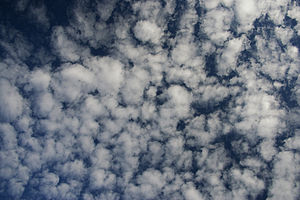Difference between revisions of "AY Honors/Weather/Answer Key"
| (One intermediate revision by the same user not shown) | |||
| Line 1: | Line 1: | ||
| − | + | [[image:altocumulus.jpg|thumb|Altocumulus cloud as seen from the space shuttle. Altocumulus is formed through convective activity.]] | |
| + | [[image:granules2.jpg|thumb|Convection cells on the Sun with North America superimposed]] | ||
| − | + | A '''convection cell''' is a phenomenon of [[fluid dynamics]] which occurs in situations where there are [[temperature]] differences within a body of [[liquid]] or [[gas]]. | |
| − | + | Fluids are materials which exhibit the property of [[flow]]. Both gases and liquids have fluid properties, and, in sufficient quantity, even particulate solids such as salt, grain, or gravel show some fluid properties. When a volume of fluid is heated, it expands and becomes less dense, and thus more buoyant than the surrounding fluid. The colder, more dense fluid settles underneath the warmer, less dense fluid and forces it to rise. Such movement is called [[convection]], and the moving body of liquid is referred to as a ''convection cell''. | |
| − | + | A rising body of fluid typically loses heat because it encounters a cold surface, because it exchanges heat with colder liquid through direct exchange, or in the example of the earth's [[earth's atmosphere|atmosphere]], because it radiates heat. At some point the fluid becomes more dense than the fluid underneath it, which is still rising. Since it cannot descend through the rising fluid, it moves to one side. At some distance its downward force overcomes the rising force beneath it and the fluid begins to descend. As it descends, it warms again through surface contact, conductivity, or compression, and the cycle repeats itself. (The heating through compression of descending air is what is responsible for such welcome winter phenomena as what is known in Western North America as a [[chinook]] or in the Alps as a [[Wind#Special winds|foehn]].) | |
| − | + | Convection cells can form in any fluid, including the Earth's atmosphere, boiling water or soup (where the cells can be identified by particles they transport, such as grains of rice), the ocean, the surface of the sun, or even a farmer's field, where large rocks have been seen to be forced to the surface over time in a process either analogous to or directly related to convection (the connection is not yet clear). | |
| − | + | The size of convection cells are largely determined by the fluid's properties, and they can even occur when the heating of a fluid is uniform. | |
| − | + | The [[Sun]]'s [[photosphere]] is composed of convection cells called ''[[Granule (solar physics)|granule]]s'', rising columns of superheated (5800 °C) [[Plasma (physics)|plasma]] averaging about 1000 kilometres in diameter. The plasma cools as it rises and descends in the narrow spaces between the granules.ALFRED WEGNER discoverd the thery of plate tectonics 8-) 8-O! | |
| − | |||
| − | |||
| − | [[ | + | ==External links== |
| + | * [http://www.solarviews.com/eng/edu/convect.htm Jet Propulsion Lab description of convection cells] | ||
| + | * [http://www.mountainnature.com/Climate/Chinook.htm Mountainnature.com - Chinook] | ||
| − | [[ | + | [[Category:Severe weather and convection]] |
| + | [[Category:Fluid dynamics]] | ||
Revision as of 00:33, 12 June 2006
A convection cell is a phenomenon of fluid dynamics which occurs in situations where there are temperature differences within a body of liquid or gas.
Fluids are materials which exhibit the property of flow. Both gases and liquids have fluid properties, and, in sufficient quantity, even particulate solids such as salt, grain, or gravel show some fluid properties. When a volume of fluid is heated, it expands and becomes less dense, and thus more buoyant than the surrounding fluid. The colder, more dense fluid settles underneath the warmer, less dense fluid and forces it to rise. Such movement is called convection, and the moving body of liquid is referred to as a convection cell.
A rising body of fluid typically loses heat because it encounters a cold surface, because it exchanges heat with colder liquid through direct exchange, or in the example of the earth's atmosphere, because it radiates heat. At some point the fluid becomes more dense than the fluid underneath it, which is still rising. Since it cannot descend through the rising fluid, it moves to one side. At some distance its downward force overcomes the rising force beneath it and the fluid begins to descend. As it descends, it warms again through surface contact, conductivity, or compression, and the cycle repeats itself. (The heating through compression of descending air is what is responsible for such welcome winter phenomena as what is known in Western North America as a chinook or in the Alps as a foehn.)
Convection cells can form in any fluid, including the Earth's atmosphere, boiling water or soup (where the cells can be identified by particles they transport, such as grains of rice), the ocean, the surface of the sun, or even a farmer's field, where large rocks have been seen to be forced to the surface over time in a process either analogous to or directly related to convection (the connection is not yet clear).
The size of convection cells are largely determined by the fluid's properties, and they can even occur when the heating of a fluid is uniform.
The Sun's photosphere is composed of convection cells called granules, rising columns of superheated (5800 °C) plasma averaging about 1000 kilometres in diameter. The plasma cools as it rises and descends in the narrow spaces between the granules.ALFRED WEGNER discoverd the thery of plate tectonics 8-) 8-O!


